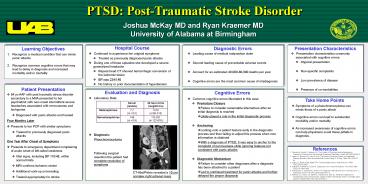PTSD: Post-Traumatic Stroke Disorder - PowerPoint PPT Presentation
1 / 1
Title:
PTSD: Post-Traumatic Stroke Disorder
Description:
PTSD: Post-Traumatic Stroke Disorder Joshua McKay MD and Ryan Kraemer MD University of Alabama at Birmingham Diagnostic Errors Presentation Characteristics – PowerPoint PPT presentation
Number of Views:83
Avg rating:3.0/5.0
Title: PTSD: Post-Traumatic Stroke Disorder
1
PTSD Post-Traumatic Stroke Disorder
Joshua McKay MD and Ryan Kraemer MD University of
Alabama at Birmingham
Diagnostic Errors
Presentation Characteristics
Learning Objectives
Hospital Course
- Continued to experience her original symptoms
- Treated as previously diagnosed panic attacks
- During one of these episodes she developed a
severe generalized headache - Repeat head CT showed hemorrhagic conversion of
the ischemic lesion - BP was 234/140
- No history or prior documentation of hypertension
- Leading cause of medical malpractice claim
- Second leading cause of preventable adverse
events - Account for an estimated 40,000-80,000 deaths per
year - Cognitive errors are the most common cause of
misdiagnosis
- Presentation characteristics commonly associated
with cognitive errors - Atypical presentation
- Non-specific complaints
- Low prevalence of disease
- Presence of co-morbidities
- Recognize a medical condition that can mimic
panic attacks - Recognize common cognitive errors that may lead
to delay in diagnosis and increased morbidity
and/or mortality
Patient Presentation
Evaluation and Diagnosis
Cognitive Errors
- 54 yo AAF with post traumatic stress disorder
secondary to a MVA presented to her psychiatrist
with new onset intermittent severe headaches
associated with nervousness and tachypnea - Diagnosed with panic attacks and treated
- Four Months Later
- Presents to her PCP with similar symptoms
- Treated for previously diagnosed panic attacks
- One Year After Onset of Symptoms
- Presents to emergency department complaining of
acute onset of left-sided weakness - Vital signs, including BP 115/48, within normal
limits - MRI confirms ischemic stroke
- Additional work-up unrevealing
- Treated appropriately for stroke
- Laboratory Data
- Diagnosis
- Pheochromocytoma
- Following surgical resection the patient had
complete resolution of symptoms
- Common cognitive errors illustrated in this case
- Premature Closure
- Failure to consider reasonable alternatives after
an initial diagnosis is reached - Likely played a role in the initial diagnostic
process - Anchoring
- Locking onto a salient feature early in the
diagnostic process and then failing to adjust
this process when new information is obtained - With a diagnosis of PTSD, it was easy to anchor
to the complaint of nervousness while ignoring
features not consistent with panic attacks - Diagnostic Momentum
- Failure to consider other diagnoses after a
diagnosis has been attached to a patient - Led to continued treatment for panic attacks and
further delayed the proper diagnosis
Take Home Points
Serum (nmol/L) 24 hour Urine (mcg/24 hrs)
Metanephrines 7.7 (nl lt0.5) 7310 (nl 90-315)
Normetanephrines 146 (nl lt0.9) 115,291 (nl 122-676)
- Symptoms of a pheochromocytoma can mimic those of
a panic attack - Cognitive errors can lead to substantial
morbidity and/or mortality - An increased awareness of cognitive errors can
help physicians avoid these pitfalls in diagnosis.
References
1. Chandra A, Nundy S, Seabury SA. The Growth of
Physician Medical Malpractice Payments Evidence
from the National Practitioner Data Bank. Health
Aff 2005W5240-9. 2. Leape LL, Brennan TA, Laird
N, et al. The Nature of Adverse Events in
Hospitalized Patients-Results of the Harvard
Medical Practice Study II. N Engl J Med
1991324377-84. 3. Leape LL, Berwick DM, Bates
DW. Counting deaths due to medical errors. JAMA
2002288(19)2405. 4. Graber M, Franklin N,
Gordon R. Diagnostic error in internal medicine.
Arch Intern Med 20051651493-1499. 5.
Kostopoulou O, Delaney BC, Munro CW. Diagnostic
difficulty and error in primary care - a
systematic review. Fam Pract 200825(6)400-13. 6.
Redman JC, Peloso OA, Milne RL, Kaminsky NI,
Ellis SC, Wolfel DA, Martinez PU. Asymptomatic
pheochromocytoma. Diagnosis after hemorrhagic
stroke in a middle-aged patient. Postgrad Med
198373(4)279,282-5.
CT-Abd/Pelvis revealed a 10 cm complex right
adrenal mass































